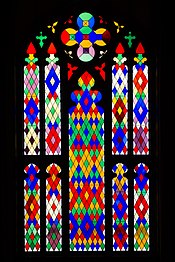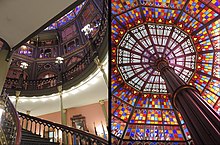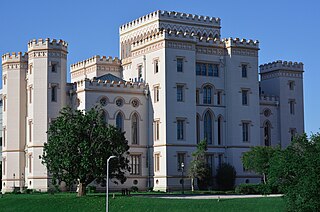
Baton Rouge is the capital city of the U.S. state of Louisiana. It had a population of 227,470 at the 2020 census, making it Louisiana's second-most populous city. It is the seat of Louisiana's most populous parish, East Baton Rouge Parish, and the center of Louisiana's second-largest metropolitan area, Greater Baton Rouge, which had 870,569 residents in 2020.

The Louisiana State Capitol is the seat of government for the U.S. state of Louisiana and is located in downtown Baton Rouge. The capitol houses the chambers for the Louisiana State Legislature, made up of the House of Representatives and the Senate, as well as the office of the Governor of Louisiana. At 450 feet (137 m) tall and with 34 stories, it is the tallest skyscraper in Baton Rouge, the seventh tallest building in Louisiana, and tallest capitol in the United States. It is located on a 27-acre (110,000 m2) tract, which includes the capitol gardens. The Louisiana State Capitol is often thought of as "Huey Long's monument" due to the influence of the former Governor and U.S. Senator in getting the capitol built. The building's construction was completed in 1931. It was listed on the National Register of Historic Places in 1978 and was designated a National Historic Landmark in 1982.

Henry Watkins Allen was a Confederate military officer who was a member in the Texian Army as a soldier, while also serving as a politician, writer, enslaver, and sugar cane planter.

The Louisiana State Museum (LSM), founded in New Orleans in 1906, is a statewide system of National Historic Landmarks and modern structures across Louisiana, housing thousands of artifacts and works of art reflecting Louisiana's legacy of historic events and cultural diversity.

Theodore C. Link, FAIA, was a German-born American architect and newspaper publisher. He designed buildings for the 1904 World's Fair, Louisiana State University, and the Mississippi State Capitol.

Baton Rouge station is a historic train station located at 100 South River Road in downtown Baton Rouge, Louisiana. It was built for the Yazoo and Mississippi Valley Railroad which got absorbed by the Illinois Central Railroad. The station was a stop on the Y&MV main line between Memphis, Tennessee and New Orleans, Louisiana. The building now houses the Louisiana Art and Science Museum.

The Pentagon Barracks, also known as the Old United States Barracks, is a complex of buildings located at the corner of State Capitol Drive and River Road in Baton Rouge, Louisiana, in the grounds of the state capitol. The site was used by the Spanish, French, British, Confederate States Army, and United States Army and was part of the short-lived Republic of West Florida. During its use as a military post the site has been visited by such notable figures as Zachary Taylor, Lafayette, Robert E. Lee, George Custer, Jefferson Davis, and Abraham Lincoln.

The Old Louisiana Governor's Mansion is located at 502 North Blvd. between Royal and St. Charles Streets in Baton Rouge and was used as Louisiana's official gubernatorial residence between 1930 and 1963; a new residence was completed in 1963. The Old Governor's Mansion was built under the governorship of Huey Long, its first resident. The building is reported to be inspired by the White House in Washington D.C. as it was originally designed by Thomas Jefferson. It is said that Long wanted to be familiar with the White House when he became president, so he had the White House duplicated in Baton Rouge. Some dispute this legend and simply say that the building is merely a fine example of a Georgian-style mansion.
James Harrison Dakin was an American architect who designed Neo-Gothic buildings and was the architect for the Old Louisiana State Capitol, Old Bank of Louisville, and other public buildings.

The Old Mississippi State Capitol, also known as Old Capitol Museum or Old State Capitol, served as the Mississippi statehouse from 1839 until 1903. The old state capitol was added to the National Register of Historic Places in 1969. In 1986, the structure was designated a Mississippi Landmark and became a National Historic Landmark in 1990.

Ursuline Convent was a series of historic Ursuline convents in New Orleans, Louisiana, United States. In 1727, at the request of Governor Étienne Perier, nuns from the Ursuline Convent of Rouen (Normandy) went to New Orleans to found a convent, run a hospital, and take care of educating young girls.
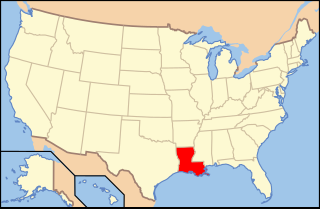
The following is an alphabetical list of articles related to the U.S. state of Louisiana.

The following is an alphabetical list of articles related to the U.S. state of Mississippi.

William Harold Nungesser is an American politician serving as the 54th lieutenant governor of Louisiana since 2016. A member of the Republican Party, Nungesser is also the former president of the Plaquemines Parish Commission, having been re-elected to a second four-year term against two opponents in the 2010 general election with more than 71 percent of the vote. His second term as parish president began on January 1, 2011, and ended four years later.
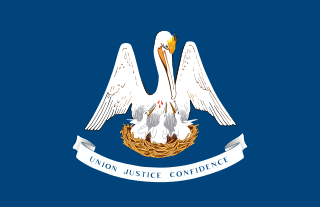
The following outline is provided as an overview of and topical guide to the U.S. state of Louisiana:

The foundation of Baton Rouge, Louisiana, dates to 1721, at the site of a bâton rouge or "red stick" Muscogee boundary marker. It became the state capital of Louisiana in 1849.
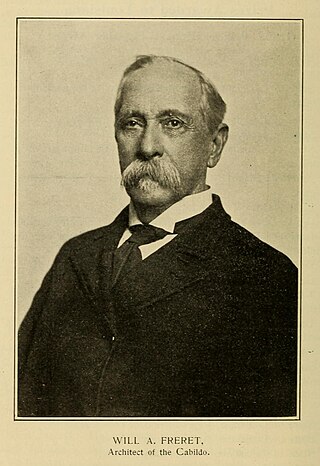
William Alfred Freret Jr. was an American architect. He served from 1887 to 1888 as head of the Office of the Supervising Architect, which oversaw construction of Federal buildings.
Albert Rieker (1889–1959) was an American sculptor. He designed public sculptures in Louisiana and Mississippi.





